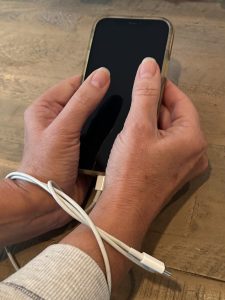Welcome to the first blog in my series on technology and its impact on mental health! From smart phones to social media to educational apps to video games, this series will share advice on how to:
- Recognize unhealthy use
- Avoid the biggest technology traps
- Set age-appropriate limits for your children
- Reverse addictive behavior patterns
- Set healthy norms at home and at work
- Know when it’s time to seek professional help
Let’s start with a check-in:
As of 2022, the average adult spends 5 hours and 24 minutes on their mobile device every day. They unlock their phone on average 96 times a day (once every 10 minutes) and swipe/click/tap over 2,600 times a day. Heavy users can reach as high as 5,000 touches a day! Would you say this sounds like you (or your child)? How many times a day do you check your phone? Do you know how many hours a day you and your family members spend in front of a screen?
By now, many of us are familiar with the worrisome data on social media and the effect of dopamine, but what happens when we’re exposed to excessive amounts of this behavior-shaping hormone regularly over a period of years? Ever wondered what that might be doing to your brain? Your child’s brain? Have we become addicted to our phones?
“People are carrying around a portable
dopamine pump, and kids have basically
been carrying it round for the last 10 years.”
Dr. David Greenfield, Assistant Clinical
Professor of Psychiatry, University of
Connecticut School of Medicine
Addiction Blind Spot: Technology
The components of addiction are fairly well known and easy to spot:
- Intense cravings
- Escalated use
- Development of increased tolerance
- Ignoring known risks
- Physical and/or social problems
It’s easy to see how this applies the use of drugs and alcohol or even binge eating or gambling. Over the last few years, the psychology community has begun to think about how these symptoms may apply to smart phones, video games, social media, and Internet use in general. As they work to develop the diagnostic criteria for technology addiction, they are looking at:
- A preoccupation with the Internet, even when the person is not online
- A sudden and drastic increase in Internet usage
- Difficulty cutting back or stopping internet usage
- Irritability, aggression, or restlessness caused by efforts to cut back on Internet use
- Unstable moods when not online or Internet use as a way to cope with stress
- Internet use interfering with job duties or academic work
- Difficulty maintaining healthy relationships when not online
- Friends and family expressing concern for the amount of time spent online
A Closer Look at Technology Addiction
Impaired control
The average adult rarely turns their phone off. Device manufacturers have made it increasingly difficult to turn phones off because they have a financial incentive for phones to always be on and connected to the Internet. The newest iPhone update makes it really difficult to activate the “do not disturb” feature without going through several steps to identify which apps and people SPECIFICALLY you want to silence. They are holding on to any connection with your phone that they can for tracking purposes. Our days very commonly begin and end with checking our phones. With the average adult interacting with their phone thousands of times a day, excessive use has become normalized. Of those who recognize they have an overuse problem, many are unable to stop. When they try to stop, if they are successful, it’s not for any meaningful period of time.
Social problems
Many people use phones as a social buffer to avoid direct interaction or as a social lubricant to initiate interaction they would be too intimidated to engage in face-to-face. People who spend too much time interacting online may actually experience some difficulty reading body language, social cues, or making small talk in person. In addition, it’s common to lose track of time while passively scrolling online. Have you ever gotten lost online and been late for an appointment, forgotten to make dinner, or missed a deadline? Have you become so reliant on your car’s navigation system that you can’t find your way to a place you’ve driven to several times without it? Do you actually know people’s phone numbers in case of emergency (i.e. you lose or break your phone) or do you just tap a name or tell Siri to dial for you?
Risky use
Despite clear rules or even laws, people often use phones and access the Internet inappropriately at work, in class, and (most dangerously) while driving. People knowingly jeopardize mental health with excessive screen time and also face physical health risks like overuse injuries involving hands, elbows, neck, eyes (ex. trapeziometacarpal osteoarthritis, digital eye strain, trigger finger, back/neck pain, and cell phone elbow). Recognizing the impact it has on you and acknowledging that you should curb use, but failing to do so despite known risks, is a sign of addiction.
Increased need
People struggling with excessive use often set screen time limits but frequently extend it by a minute, by 15 minutes, and then ignore the limit altogether. They make deals with themselves that this will be the last time. There may have been a time when they checked their phones only when they were expecting something important, but they now passively scroll just hoping for something…anything interesting. They don’t know what they’re looking for, but they keep looking anyway and they do so roughly every 10 minutes. It’s easy to see how this compulsive checking interferes with being present during school, work, and family time.
The Covid-19 Effect
Let’s be honest, we probably weren’t doing all that great managing technology use before COVID-19, but once the lockdown hit, we all went a little nuts…out of necessity. Our work meetings were held on Zoom while our children spent 18 months being educated online. We couldn’t see our friends in person so we stayed connected over our phones. We FaceTimed, Snapped, DM’d. We entertained ourselves with never-ending YouTube content and binge-watched Netflix shows. We kept up with people over Facebook, Instagram, and SnapChat. We scratched our creative itch making TikTok videos. We turned to the 24-hour news channels to get updates on what we were supposed to do next. We needed connection AND information, but we paid a price for that.
Now What?
Our use during lockdown made sense for the most part, but reentry to normal life has been difficult for some and for kids, in particular. We adults picked up a lot of bad habits during lockdown and so did our kids. However, that 18 months is a much larger percentage of a kid’s life than an adult’s life. We can’t underestimate the impact that technology overuse had on the way kids learned, developed social skills, or established behavior norms around technology. But lockdown is over and we need to get it together for ourselves and for our kids who are watching us. It’s time to rein it in. Just like that time we went on vacation and ate and drank ALL the things. That was fun, but technologically speaking, we need to eat some fruit, touch grass, and drink water.
Next week, we will look at the most problematic types of technology and then we’ll get down to the business of undoing all this excess. Stay tuned!




